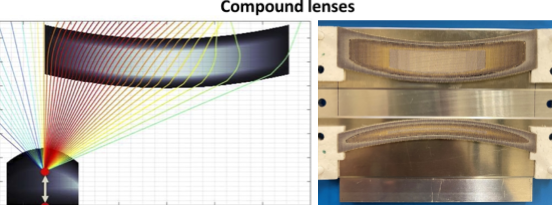Low-complexity and Low-power Millimeter-wave Bean-scanning Antennas for NextG Networks

Overview
One of the key challenges of millimeter wave systems is the increased path loss at high frequencies compared with current sub-6 GHz wireless networks. A proposed solution is to employ high-gain antenna arrays which compensate for the path loss but have a corresponding narrow beamwidth. In order to maintain a wireless link with a mobile device, beam-steering is employed. Traditional beam-steering uses active phased arrays which incur a high cost and power dissipation. An alternative to active phased array beam steering antennas is the passive Luneberg lens which boasts zero power dissipation, low-loss, and high gain. However, the Luneberg lens is a bulky 3D (spherical) gradient index (GRIN) lens traditionally requiring elaborate machining of concentric shells of dielectric. Due to the difficulties of fabrication this lens has traditionally only been realized in bands below 20 GHz.
Lens antennas
With recent advances in additive manufacturing of high-performance and low-loss RF materials, such GRIN lenses can be realized with a low-profile while maintaining their wideband performance. However, the reduction in volume results in unavoidable degradation in beam-scanning performance, reducing the field-of-view and limiting its use in modern mobile wireless networks. To address this Professor Chisum and his team have proposed several novel architectures including compound and hybrid lens architectures comprising collections of several lenses or combinations of sparse phased-arrays and lenses, respectively. Professor Chisum is sponsored by the Office of Naval Research and has collaborations with leading 3D-printing companies in industry in order to prove the methods are viable in the current and future bands for 5G and 6G wireless networks.

In order to realize GRIN lenses we have developed a suite of manufacturing processes for gradient index media targeting the millimeter wave bands from 8-100+ GHz. One method, based upon a perforated dielectric, mixes air and dielectric in varying ratios throughout the volume of the lens in order to sculpt the electromagnetic fields as they propagate through the lens. This method is highly reliable, extremely wideband, and very low loss. It can currently be realized by drilling standard high-frequency PCB substrates or through 3D printing. A lower-cost alternative is based upon a metallo-dielectric mixture in which small metal inclusions provide strong localized polarization. These methods are amenable to standard PCB printing and are thus very low-cost. While their frequency response is traditionally narrowband due to material resonances, we have been exploring methods to push the material resonances out of the bands of interest. This method currently supports operation up to 40 GHz.
One of the advantages of a GRIN lens is the many degrees of freedom available for design. This permits a designer to simultaneously pursue multiple design objectives such as bandwidth, efficiency, wide field-of-view, and even low sidelobe levels. However, such a multi-objective optimization requires a rapid and accurate numerical solver. Current state-of-the-art electromagnetic solvers using high-performance computing (HPC) clusters still require hours to solve a single iteration of the lens optimization. Therefore we have developed in-house codes which combine curved-ray geometrical optics with diffraction theory in order to solve the radiation pattern of a lens candidate in less than one minute, and with ~0.1dB accuracy compared to the full-wave electromagnetic solvers.
A new networking paradigm
The hardware is now mature and capable of offering high-performance millimeter-wave beam-scanning antennas for mobile wireless base-stations, or for tracking of low-earth-orbit (LEO) satellite communications. The next phase of this research is to collaborate with other WI researchers in order to demonstrate network-level properties including beam identification and tracking, search and track, make-before-break capabilities, and even the ability to operate with a deployed 5G NR waveform.
Sponsors and Collaborators
The GRIN lens antenna project is currently funded by the Office of Naval Research (ONR) and the Department of Homeland Security (DHS) with past support ship from the Satcom industry. We are collaborating with industry-leading additive manufacturing companies including Fortify and NanoDimension, as well as MIT Lincoln Laboratory.
Publications
N. Garcia, J. Chisum, “Compound GRIN Fanbeam Lens Antenna with Wideband Wide-angle Beamscanning“ IEEE Transactions on Antennas and Propagation, Jun. 2022
N. Garcia, W. Wang, J. Chisum, “Feed Corrective Lenslets for Enhanced Beamscan in Lens Antenna Systems“ Optica Express, Apr. 2022
W. Wang, N. Garcia, and J. Chisum, “The Systematic Design of Non-commensurate Impedance Matching Tapers for Ultra Wideband Gradient Index (GRIN) Lens Antennas“ IEEE Transactions on Antennas and Propagation, Jul. 2021
N. Garcia, J. Chisum, “Reduced dimensionality optimizer for efficient design of wideband millimeter‐wave 3D metamaterial GRIN lenses“ Microwave and Optical Technology Letters, May 2021
N. Garcia, J. Chisum, “High-Efficiency, Wideband GRIN Lenses With Intrinsically Matched Unit Cells“ IEEE Transactions on Antennas and Propagation, Apr. 2020
W. Wang, J. Chisum, “Hybrid Geometrical Optics and Uniform Asymptotic Physical Optics for Rapid and Accurate Practical GRIN Lens Design“ 2022 IEEE/MTT-S International Microwave Symposium, Jun. 2022

